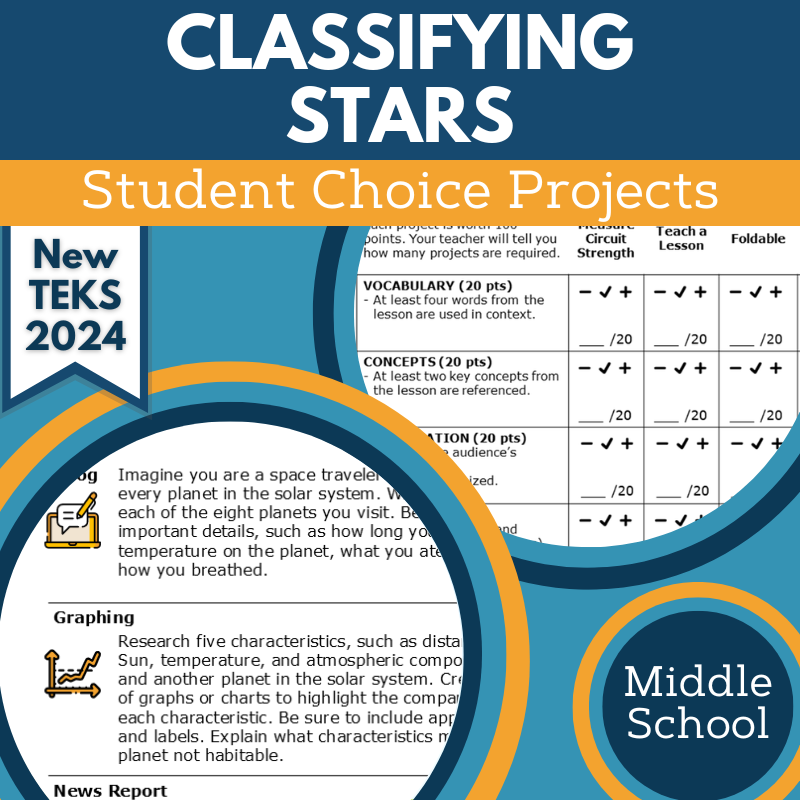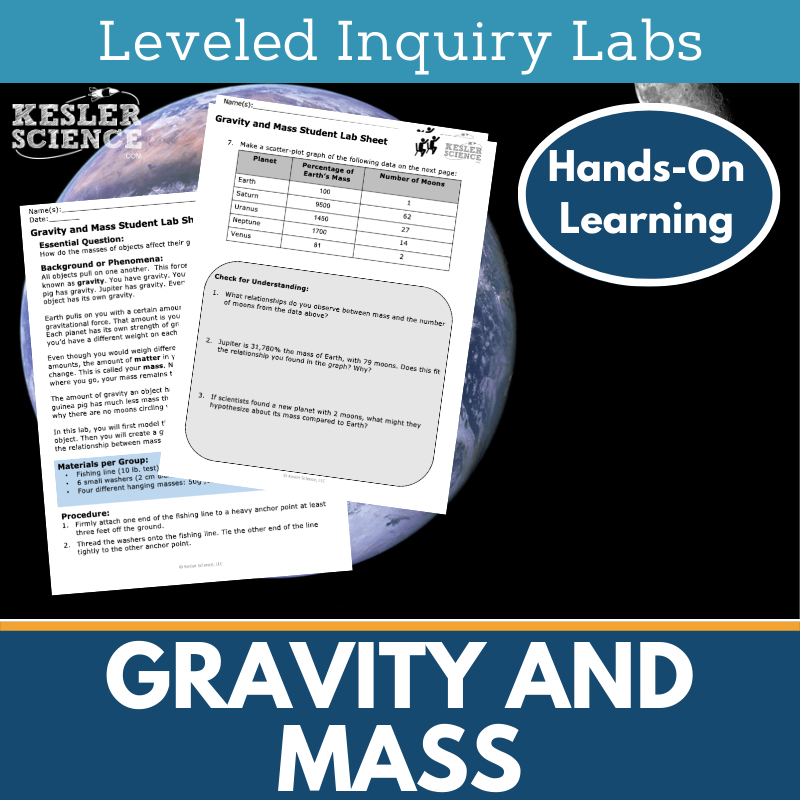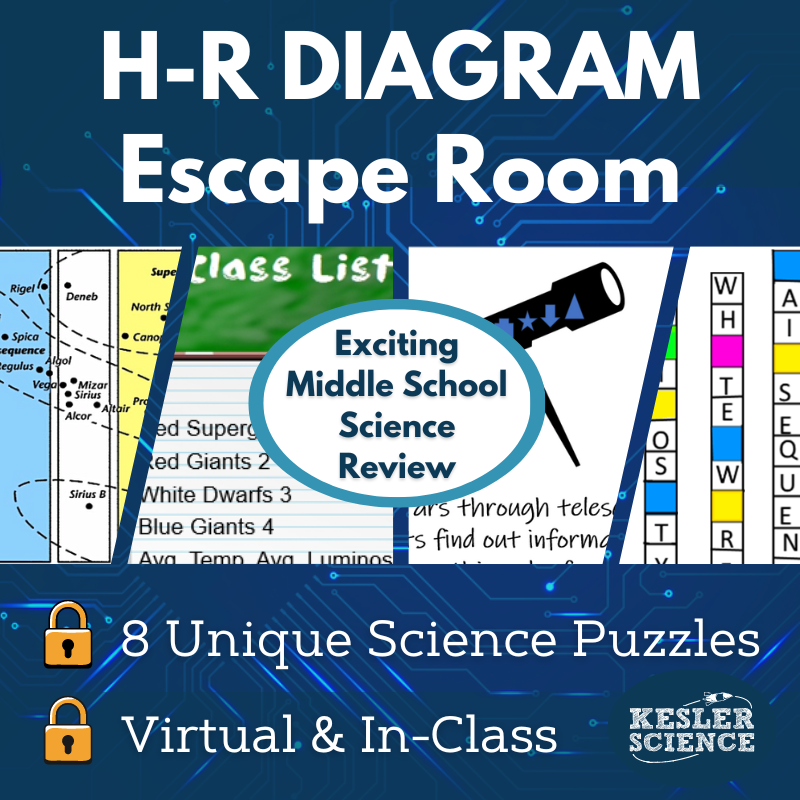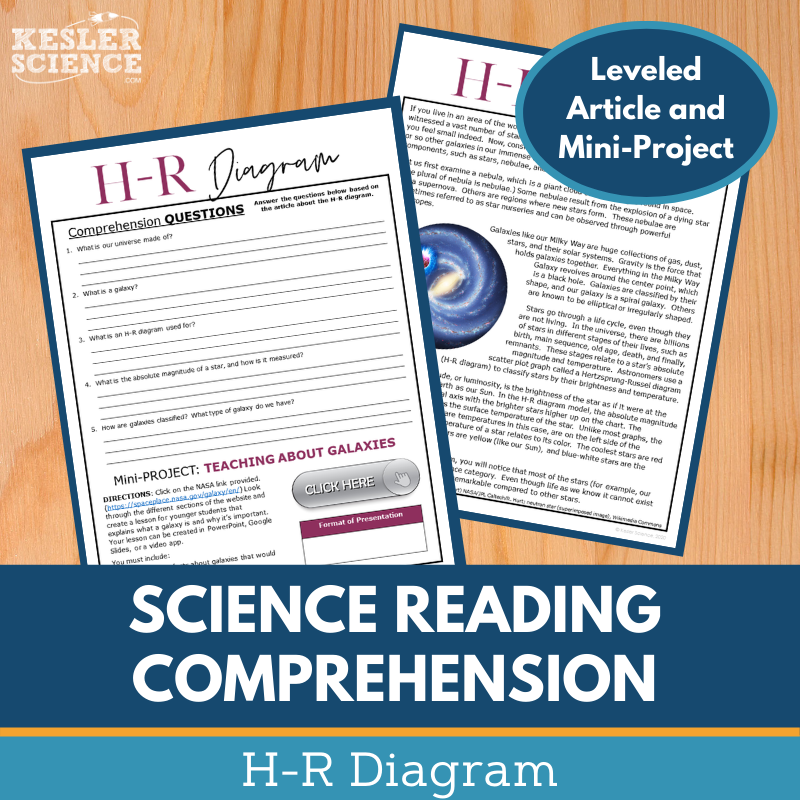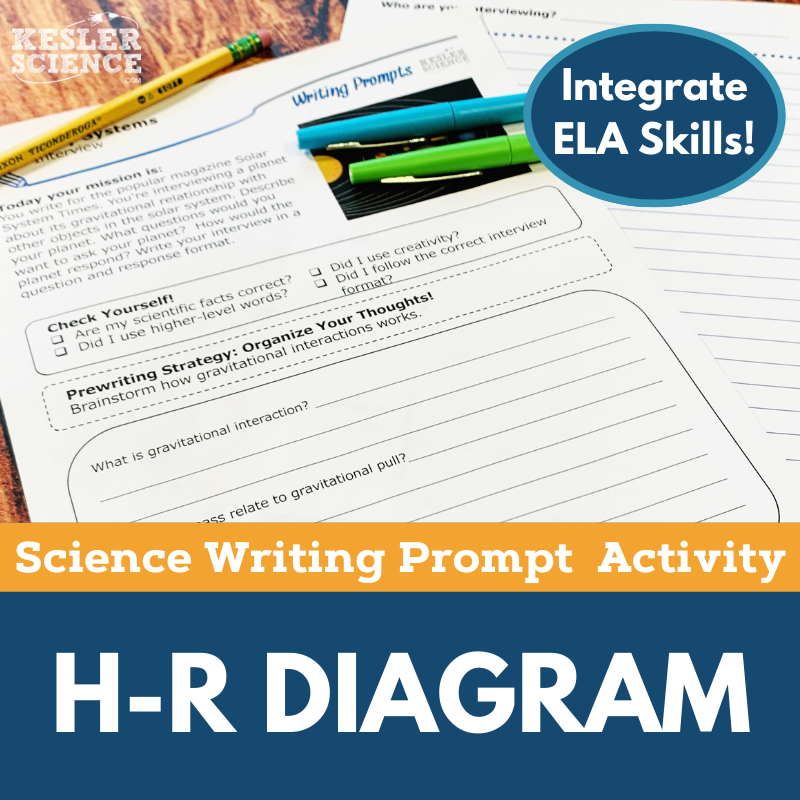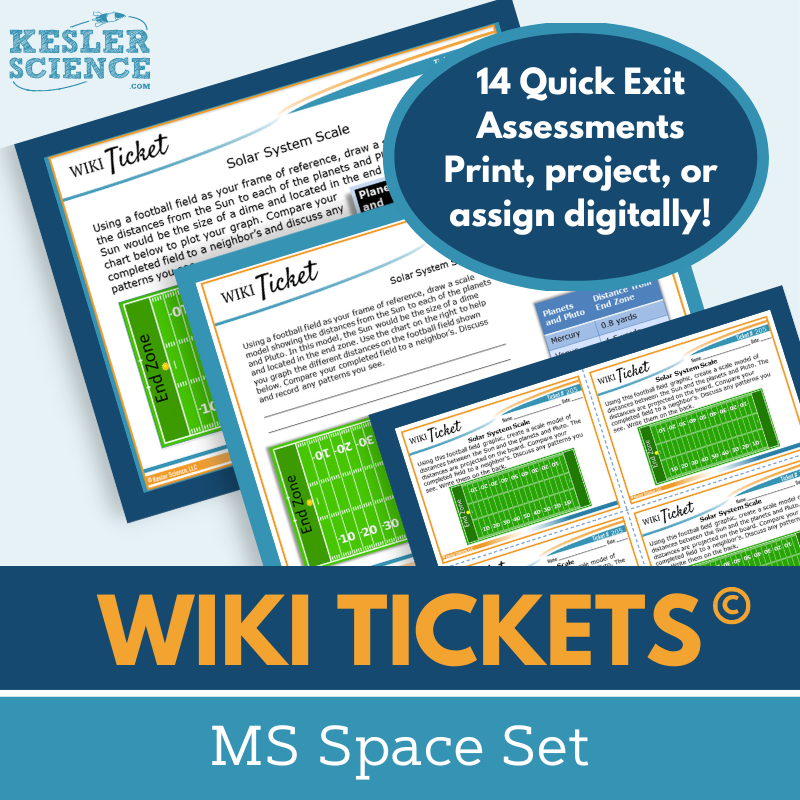Classifying Stars Activities for Middle School Science
Understanding the complete life cycle of stars and the H-R diagram is essential for middle school students, but it can be a challenging concept to grasp! The resources below will give students a comprehensive understanding of classifying stars. All of the following materials are also included in the Kesler Science Membership.
This Complete Life Cycle of Stars & H-R Diagram Lesson aligns with TEKS 2021 standard 8.9A, helping students explore stellar evolution and star classification using the Hertzsprung-Russell Diagram. Built on the 5E Model, this low-prep, student-led resource includes editable presentations, worksheets, choice projects, and assessments to support differentiated learning.
Students engage through nine station lab activities, covering hands-on experiments, research, videos, readings, and creative projects. Editable PowerPoints, interactive notebooks (digital and print), and STAAR 2.0-aligned assessments provide structured learning with Spanish translations for accessibility.
Perfect for in-class or virtual learning, this lesson is available in the Space MS Complete Lesson Bundle (eight topics) or the MS 2024 Mega Complete Curriculum Bundle (84 topics)—giving you everything you need to make space science engaging while saving time!
This Complete Life Cycle of Stars & H-R Diagram Lesson aligns with TEKS 2021 standard 8.9A, helping students explore stellar evolution and star classification using the Hertzsprung-Russell Diagram. Built on the 5E Model, this low-prep, student-led resource includes editable presentations, worksheets, choice projects, and assessments to support differentiated learning.
Students engage through nine station lab activities, covering hands-on experiments, research, videos, readings, and creative projects. Editable PowerPoints, interactive notebooks (digital and print), and STAAR 2.0-aligned assessments provide structured learning with Spanish translations for accessibility.
Perfect for in-class or virtual learning, this lesson is available in the Space MS Complete Lesson Bundle (eight topics) or the MS 2024 Mega Complete Curriculum Bundle (84 topics)—giving you everything you need to make space science engaging while saving time!
This Classifying Stars Station Lab aligns with TEKS 2021 standard 8.9A, helping students explore the life cycle of stars and classify them using the Hertzsprung-Russell diagram. Through a modular, student-led approach, students understand that the term “life cycle” refers to a star’s stages, not biological life. This resource is perfect for both in-class and virtual learning.
With nine differentiated stations, students engage in hands-on activities, videos, readings, and research. They demonstrate their understanding through organizing, illustrating, writing, and assessments, with a bonus Challenge It! station for advanced learners.
This ready-to-use resource includes all materials, task cards, and digital options for PowerPoint and Google Slides, making it a flexible and engaging way to explore star classification. It’s also part of the Space Science Station Lab Bundle, which includes eight space labs.
This Classifying Stars Station Lab aligns with TEKS 2021 standard 8.9A, helping students explore the life cycle of stars and classify them using the Hertzsprung-Russell diagram. Through a modular, student-led approach, students understand that the term “life cycle” refers to a star’s stages, not biological life. This resource is perfect for both in-class and virtual learning.
With nine differentiated stations, students engage in hands-on activities, videos, readings, and research. They demonstrate their understanding through organizing, illustrating, writing, and assessments, with a bonus Challenge It! station for advanced learners.
This ready-to-use resource includes all materials, task cards, and digital options for PowerPoint and Google Slides, making it a flexible and engaging way to explore star classification. It’s also part of the Space Science Station Lab Bundle, which includes eight space labs.
These Classifying Stars Student Choice Projects align with TEKS 2021 standard 8.9A, allowing students to explore the life cycle of stars and classify them using the Hertzsprung-Russell diagram through six project options or a design-your-own approach. A flexible grading rubric supports teacher, peer, or self-assessment, and this resource is also included in the Classifying Stars Complete Lesson.
The projects are differentiated to meet the needs of all learners, with a modified version for students needing support and more challenging options for advanced students. The Space Bundle offers eight topics, and the MEGA Student Choice Project Bundle includes 84 topics for Grades 6-8.
Low-prep and multimodal, these projects use common classroom supplies or can be completed digitally. This versatile, ready-to-use resource promotes creativity and deepens students' understanding of space science.
These Classifying Stars Student Choice Projects align with TEKS 2021 standard 8.9A, allowing students to explore the life cycle of stars and classify them using the Hertzsprung-Russell diagram through six project options or a design-your-own approach. A flexible grading rubric supports teacher, peer, or self-assessment, and this resource is also included in the Classifying Stars Complete Lesson.
The projects are differentiated to meet the needs of all learners, with a modified version for students needing support and more challenging options for advanced students. The Space Bundle offers eight topics, and the MEGA Student Choice Project Bundle includes 84 topics for Grades 6-8.
Low-prep and multimodal, these projects use common classroom supplies or can be completed digitally. This versatile, ready-to-use resource promotes creativity and deepens students' understanding of space science.
In this H-R Diagram Lab, students use data to interpret and graph stars such as main sequence, red giants, and white dwarfs, plotting them on the Hertzsprung-Russell diagram based on temperature and luminosity. This student-led, differentiated lab is perfect for engaging students while saving you prep time.
The resource includes three lab versions: Dependent, Modified, and Independent, each designed to meet varying levels of student need. It includes editable teacher resources, answer keys, and CER reflection questions for assessment.
Aligned with TEKS, this complete lab set uses basic materials like colored pencils and the Stellar Life Cycle chart (for the independent version). Available in the Complete Inquiry Labs Bundle and Space Inquiry Labs Bundle, it’s a ready-to-use, low-prep resource to help students understand star classification through hands-on learning.
In this H-R Diagram Lab, students use data to interpret and graph stars such as main sequence, red giants, and white dwarfs, plotting them on the Hertzsprung-Russell diagram based on temperature and luminosity. This student-led, differentiated lab is perfect for engaging students while saving you prep time.
The resource includes three lab versions: Dependent, Modified, and Independent, each designed to meet varying levels of student need. It includes editable teacher resources, answer keys, and CER reflection questions for assessment.
Aligned with TEKS, this complete lab set uses basic materials like colored pencils and the Stellar Life Cycle chart (for the independent version). Available in the Complete Inquiry Labs Bundle and Space Inquiry Labs Bundle, it’s a ready-to-use, low-prep resource to help students understand star classification through hands-on learning.
The H-R Diagram Escape Room is an interactive experience that allows students to demonstrate their knowledge of the Hertzsprung-Russell diagram. Aligned with TEKS, this escape room helps students understand star classification, nebulae, and galaxies in an engaging, hands-on way.
With eight unique puzzles, this escape room is customizable—the teacher can choose which puzzles to use and in what order, making it suitable for any class period. You can run it with manila envelopes for a simple setup or a more immersive experience with locks and a storage box. The digital version can also be used for remote learning via Google Slides or PowerPoint.
Teacher directions, answer keys, digital answer sheets, reward templates, and over 50 prize ideas are all included. This is a fun, low-prep resource for reinforcing space science concepts while keeping students engaged and excited!
The H-R Diagram Escape Room is an interactive experience that allows students to demonstrate their knowledge of the Hertzsprung-Russell diagram. Aligned with TEKS, this escape room helps students understand star classification, nebulae, and galaxies in an engaging, hands-on way.
With eight unique puzzles, this escape room is customizable—the teacher can choose which puzzles to use and in what order, making it suitable for any class period. You can run it with manila envelopes for a simple setup or a more immersive experience with locks and a storage box. The digital version can also be used for remote learning via Google Slides or PowerPoint.
Teacher directions, answer keys, digital answer sheets, reward templates, and over 50 prize ideas are all included. This is a fun, low-prep resource for reinforcing space science concepts while keeping students engaged and excited!
This Hertzsprung-Russell Diagram Reading Lesson helps students explore components of the universe and how they are classified using the Hertzsprung-Russell diagram. The lesson includes a nonfiction article, comprehension questions, and a hands-on mini-project where students create a presentation about galaxies. This resource is designed to engage middle school students while building science literacy and reading comprehension.
The leveled articles (Lexile levels: 1100-1300) are perfect for grades 6-8 and include a Cornell notes template. The lesson is fully digital-compatible, making it ideal for both in-class and virtual learning environments like Google Classroom and Schoology. This resource is great for absent students, extra credit, or sub plans, and helps deepen students’ understanding of space science while improving textual analysis skills.
This Hertzsprung-Russell Diagram Reading Lesson helps students explore components of the universe and how they are classified using the Hertzsprung-Russell diagram. The lesson includes a nonfiction article, comprehension questions, and a hands-on mini-project where students create a presentation about galaxies. This resource is designed to engage middle school students while building science literacy and reading comprehension.
The leveled articles (Lexile levels: 1100-1300) are perfect for grades 6-8 and include a Cornell notes template. The lesson is fully digital-compatible, making it ideal for both in-class and virtual learning environments like Google Classroom and Schoology. This resource is great for absent students, extra credit, or sub plans, and helps deepen students’ understanding of space science while improving textual analysis skills.
The H-R Diagram Science Writing Prompt Activity lets middle school students creatively explore their knowledge of stars, nebulae, galaxies, and the Hertzsprung-Russell diagram through poetry. This engaging, student-centered activity enhances science reasoning and allows for personalized exploration of space science topics.
Aligned with TEKS, this low-prep, differentiated resource includes teacher directions, rubrics, and digital options for Google Slides or PowerPoint—perfect for both in-class and remote learning. This versatile prompt works for extra credit, make-up work, or as a student choice project and is available in the Earth Science, Life Science, and Physical Science bundles.
Use it for cross-curricular activities, formative assessments, or as a fun way to challenge students’ writing while reinforcing key science concepts!
The H-R Diagram Science Writing Prompt Activity lets middle school students creatively explore their knowledge of stars, nebulae, galaxies, and the Hertzsprung-Russell diagram through poetry. This engaging, student-centered activity enhances science reasoning and allows for personalized exploration of space science topics.
Aligned with TEKS, this low-prep, differentiated resource includes teacher directions, rubrics, and digital options for Google Slides or PowerPoint—perfect for both in-class and remote learning. This versatile prompt works for extra credit, make-up work, or as a student choice project and is available in the Earth Science, Life Science, and Physical Science bundles.
Use it for cross-curricular activities, formative assessments, or as a fun way to challenge students’ writing while reinforcing key science concepts!
The Space WIKI Tickets© Formative Assessments provide a fun, engaging way to check student understanding of space science topics for 6th-8th grade. This set includes 14 topics with five formats for flexibility: full-screen display, three handout sizes, and interactive digital versions (editable PPT or Google Slides).
Aligned with NGSS and TEKS standards, these assessments cover essential space science topics like the H-R Diagram, electromagnetic spectrum, solar system gravity, space exploration, and more. They can be used as exit tickets, bellringers, or to gauge progress in in-person or virtual settings.
These easy-to-use resources are perfect for quickly checking comprehension and ensuring engaged learning throughout your space science unit.
The Space WIKI Tickets© Formative Assessments provide a fun, engaging way to check student understanding of space science topics for 6th-8th grade. This set includes 14 topics with five formats for flexibility: full-screen display, three handout sizes, and interactive digital versions (editable PPT or Google Slides).
Aligned with NGSS and TEKS standards, these assessments cover essential space science topics like the H-R Diagram, electromagnetic spectrum, solar system gravity, space exploration, and more. They can be used as exit tickets, bellringers, or to gauge progress in in-person or virtual settings.
These easy-to-use resources are perfect for quickly checking comprehension and ensuring engaged learning throughout your space science unit.
Lesson Extensions offer critical thinking and creative activities to engage fast finishers and scaffold learning in space science lessons. These activities, aligned with NGSS and TEKS standards, include Puzzler (problem-solving), Maker Space (hands-on STEAM), Tech Connection (digital learning), and Word Master (creative writing).
Each extension includes teacher directions, answer keys, and both projection and paper formats. Topics cover gravity, space travel, the lunar cycle, and more, providing a flexible way to deepen students’ understanding while keeping them engaged in both in-person and virtual settings.
Lesson Extensions offer critical thinking and creative activities to engage fast finishers and scaffold learning in space science lessons. These activities, aligned with NGSS and TEKS standards, include Puzzler (problem-solving), Maker Space (hands-on STEAM), Tech Connection (digital learning), and Word Master (creative writing).
Each extension includes teacher directions, answer keys, and both projection and paper formats. Topics cover gravity, space travel, the lunar cycle, and more, providing a flexible way to deepen students’ understanding while keeping them engaged in both in-person and virtual settings.
This Amazing Anchors lesson helps you easily incorporate an anchoring phenomenon into your lesson on H-R Diagrams. The resource is split into two parts: the first includes an introductory reading on the brightness of stars, followed by comprehension and extension questions, while the second is an explanatory reading that breaks down the science behind the H-R Diagram, with additional questions to reinforce learning.
Aligned with TEKS, this lesson is available in both print and digital formats, making it ideal for Google Classroom or other LMS. It comes with teacher directions, answer keys, and options for differentiation to support a variety of learning needs.
This resource is perfect for introducing or wrapping up your lesson on H-R Diagrams, providing easy-to-implement materials for both in-person and virtual learning.
This Amazing Anchors lesson helps you easily incorporate an anchoring phenomenon into your lesson on H-R Diagrams. The resource is split into two parts: the first includes an introductory reading on the brightness of stars, followed by comprehension and extension questions, while the second is an explanatory reading that breaks down the science behind the H-R Diagram, with additional questions to reinforce learning.
Aligned with TEKS, this lesson is available in both print and digital formats, making it ideal for Google Classroom or other LMS. It comes with teacher directions, answer keys, and options for differentiation to support a variety of learning needs.
This resource is perfect for introducing or wrapping up your lesson on H-R Diagrams, providing easy-to-implement materials for both in-person and virtual learning.
Year-Round Resources
These year-round activities will increase your students' understanding of many middle school science topics. All of these activities are also included in the Kesler Science Membership.
Visual Data & Graphing
You're not alone if your students struggle with understanding graphs, charts, and tables. It's a skill that takes an enormous amount of practice. This resource will help students build a strong foundation in analyzing data and creating their own data visualizations.
Bell Ringers and Warm-Ups
These middle school science bell ringers are an excellent way to engage your students as soon as they walk into your classroom. This comprehensive FULL YEAR resource includes everything you need to start off each science class with an interesting warm-up activity.
Review Board Games
Each game board has been carefully designed to keep students engaged. There are 10 different action spaces on each board and dozens of question cards. All of the actions are related to science concepts and keep the students motivated throughout the game.
Each game is ready to play. Simply print out the board and the cards and let the students enjoy reviewing nine different units.
Essential Questions and Standards
Below are the essential questions and standards associated with the lessons and activities included in the atoms unit. This topic is only one of more than 100 middle school science topics included in the Kesler Science Membership.
-
Can you describe the life cycle of a star?
-
How do we use the H-R Diagram to help to compare and classify stars?
-
TEKS Science - 8.9A Classifying Stars
Kesler Science Membership
Imagine never having to search for another middle school science lesson again. The membership gives you access to ALL of the Kesler Science products in one place (Yes, including everything above).
Say goodbye to long hours of lesson prep.





